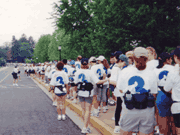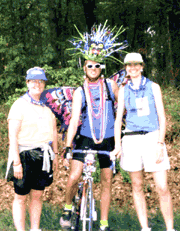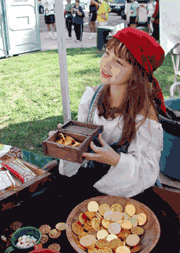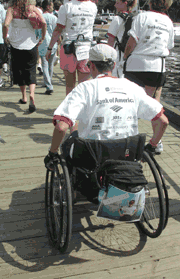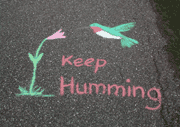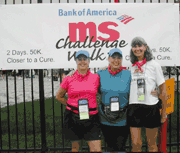|
|||||||||||||||
Long Strides toward a Cure
Walking 30, 50 even 60 miles isn’t the half of itstory and photos by Dotty Holcomb DohertyGasping briefly, I tie a wet cold bandana around my neck. I head out for a training walk under the steady buzz of cicada, preparing for the Chesapeake Bay MS Challenge Walk. I leave before the real heat of the day sets in, with its unbidden promise of 100 degrees, and find the nearest shade. I know the drill; I have done this before. I began challenge walking six years ago after reading a full-page ad for a Washington, D.C., Avon Breast Cancer Three-Day Walk. A multi-sport athlete and coach, I was trying to accept that walking was a worthy sport. Sixty miles in three days seemed like a credible challenge. I called my college friend and sister athlete Elaine Hoffman and convinced her to join me. Then came the tougher part. We each had to raise $1,500. I had never raised that kind of money, just helped on school bake sales and car washes. I began by writing to my friends, telling them what I was doing. Their response was overwhelming. I had no idea how many of my friends had been touched by breast cancer. With colorful fabric markers, I covered both sides of my shirt with their family members and friends’ names, one list in memory of those who had died, the other in celebration of survivors. Thoughts of my own surviving friends and cousin with breast cancer kept me going both in training and later on the long 20-mile days from Frederick to D.C.
I raised well over the minimum, and, having trained judicially, I felt I was ready. But I was not prepared for the emotions that would well up in me as we walked. Several of the walkers had silk-screened photos on their shirts, women smiling courageously under bald heads. Others simply had words: “In memory of my mother” … “We love you Allie” … “For my sister.” I was not prepared for how often I would cry over people I would never meet. I was also not prepared for the amazing support of bystanders. One man leap-frogged ahead of us in his car, then sat and cheered as our long jagged line went by. Each time we passed him, he’d changed into a different college T-shirt, keeping us greatly amused and spurred on by curiosity. Children at a school for the deaf jumped and cheered, signing wildly; the thumb and two-finger message I love you dancing between us. Members of a motorcycle club kept us safe at every intersection, always with a smile and encouragement, one man high-fiving every person also walked by. All 2,500 of us. Butterfly guy, a colorfully dressed man wearing wings, bicycled along with the walkers at the back — many of them pink-shirted survivors — shepherding everyone to the finish. Small gestures made a big difference. One woman’s sign, “Thank you for walking,” made me feel that each step I took was important. Symbolically, those steps gave us hope, as the millions we raised would go to research and to supporting those with cancer. A New ChallengeElaine and I walked 60 miles the following year through her hometown in central Georgia, making plans to walk in Breast Cancer Three-Days for many years, going to different locations all over the country. But after this second walk, we switched our focus. In 2002, I was diagnosed with multiple sclerosis. For the next year, I was beset with impaired vision and a whole-body buzzing and numbness that made it painful to walk. Relentless fatigue overwhelmed me, and I finally had to give up my teaching job. Slowly, my symptoms improved. When Elaine initially suggested we do the Chesapeake Bay MS Challenge Walk in 2004, I didn’t think I could make it. I had walked in the three-mile Annapolis MS walk in 2003, but felt I didn’t have the energy for the long ones anymore, as fatigue became a perpetual symptom. Then, I learned that a hometown friend’s MS had moved to the progressive state, when symptoms don’t go away as they usually do with the relapsing-remitting form I had. Her vision, her ability to think and to walk without assistance — all had deteriorated. I knew it was time. I needed to walk for her because I still could. We would walk this time with hundreds instead of thousands. Though 400,000 people live with MS in the United States, including over 5,000 in Maryland, the disease is not well known. Breast cancer is diagnosed in someone in the U.S. every three minutes; MS is diagnosed in someone every hour. When I was diagnosed, I had no idea what it meant and found myself on the Internet trying to understand my future. MS is an autoimmune disease, meaning my own immune system could attack my brain, spinal cord or optic nerve without warning. I began daily injections of a disease-modifying drug in hopes of slowing its progression, but I had no way of knowing how MS would affect me. Though typically it is not life-threatening, a multitude of symptoms are possible, from difficulty walking, swallowing and speaking to muscle tremors, blindness and paralysis. I had entered a life of mystery. I began training again. Now, I needed to learn patience as I chided myself for not walking far enough, having discovered during previous training that 15 miles is a lot tougher than 10. We would need to walk 20 the first day, and I only was averaging three to five miles with occasional eights. But I was walking. And I had raised double the minimum: $3,000. With Elaine by my side, I walked every step of the 50 miles. Through Annapolis and up the B&A trail. Around BWI airport and finally to the Inner Harbor along the streets of Baltimore. At It Again
Now, I am at it again. Once again, I have raised the money. I keep training despite the heat, hoping to complete the challenge walk — this time a 50K — in two days. I stop at a water fountain and rewet my bandana. What makes us walk these long distances? Why not stick to the shorter, three-mile walks? I have walked with people who admitted their feet felt like they were walking on razor blades. Whose blisters bled. Whose toenails had fallen off during training. Twice. Who walked with crutches and pushed themselves in wheelchairs. What motivates us, beyond the obvious desire to raise money to help people afflicted with these diseases? Maybe because we enjoy the high spirits of the walkers, like those on the 2004 MS Challenge Walk. People like tutu-man. A stout man, he wore a crinkly orange tutu over black shorts, a slight smile framed by his groomed beard. “I figured my friends and co-workers would donate more money if I told them I would wear a tutu on the walk,” he said. They did, and he was true to his word, wearing a different colored tutu each day, saving the special pink one for last. A bouncy team of divers chanted and sang the whole route. Each had a friend or family member with MS, and they had come from all over the East Coast to walk. We shook our heads, marveling at their jubilant spirits even on the third day, but their enthusiasm was infectious and kept us going. The Rev. Skip Koritzer of Baltimore greeted walkers at a rest stop with his boom box blaring. He hugged the women and high-fived the men. He sang and cheered. We had to laugh as he twirled us around and told us we were wonderful and beautiful despite our grime and sweat. Near the end, as all the walkers met before parading the last miles together to the finish line, he led us in a rousing conga-line, the only person I know who could convince all those tired bodies to dance. I am looking forward to this year’s challenge walk. To the people I will meet: the courageous and the humble, the determined and the slightly nutty. Arriving from Pennsylvania, Virginia, Maryland and beyond, we will converge in Annapolis on opening day, and we will walk, united in our purpose: to help find a cure for MS. Day One
Overcast skies and misty showers keep us cool on the first day of the walk. Stepping off the 50 yard line of the Navy-Marine Corps Memorial Stadium to the cheers of our supporters, we begin our journey of 31 miles. The first miles flow easily as my body remembers the rhythms found during training. Walking with Elaine and her sister Susan Hoffman Melendez, we chat and tell stories, catching up on each other’s lives. Cheerful crews decorate their rest stops in different themes: Cowboys welcome us at one, smiley faces at another. My husband Jonathan, daughter Helen and her friends Finley Ferro and twins Dillon and Tucker Scherger run a stop called Fishing for a Cure, with colorful Cure fish chasing away evil MS fish. Back rubs and hugs renew us. The Annapolis High School juniors wave signs at passing motorists — Honk 4 a Cure to MS — and the resounding beeps spur us on. Jonathan’s chalk messages along the B&A Trail make us smile. After seven miles, my calves began to tighten a bit, but my spirits and energy remain high. We stop three times, however, to fix Susan’s feet — covering hot spots with moleskin to try to prevent blisters — and many walkers pass us. It’s not a race, we remind ourselves and keep our steady pace. Fatigue sets in as we approach 10 miles, and we look forward to a break. We have been walking for four hours. We can see the lunch stop ahead, but the white tent seems a mirage. Will we ever get there? Team Wench’s Renaissance-costumed rogues, fair maidens and pirates usher us in, offering gold coins to accompany the lunch spread before us. Madrigals boom from speakers, and just sitting down rejuvenates us. We repair Susan’s feet and enjoy our well-earned rest. Some walkers make it only this far and are shuttled in vans back to the hotel, but we are ready to troop on. We stride out with determination, joining the last walkers. But now, bodies complain. With 10 miles to go, aches settle into joints and hot spots turn into blisters. Paces slow. Succumbing to the Doppler Effect, the B&A trail’s miles are no longer compressed as they were earlier but stretch before us, lengthening with each step. Inertia is real. A body in motion does stay in motion, but a body at rest … well, let’s say we begin to wonder if we will stand up again at each porta-potty stop. Benevolent crew on bikes are our constant support system. Up and down the trail they ride, bringing first aid, water and their endless encouragement, cheering us on with a smile. At the mile-17 rest stop, we assure the crew that some are still behind us. A biker shakes his head. “No,” he says. “You’re it. The rest have been shuttled.” In those final miles of the day, walkers find their inner strength — or inner silliness — to keep going. One group, on passing a church’s sign, launches into B-I-N-G-O was his name-oh. Gross jokes are pulled out, stories get funnier. Some chant rhythmic songs, others silently persevere. A rest stop with palm trees and freshly made slushies is a godsend. Flavored ice never tasted so good. At mile 19, Elaine’s back pain becomes extreme and she chooses the shuttle. Susan, admitting she feels like she is walking on wooden stumps, continues. “I’ve never done this before,” she says. “I can’t quit.” A mile and a half to go feels endless, but we and the rest of the last walkers make it. More chalk messages from my family lighten our hearts as we leave the BWI airport trail and arrive at Lindale Middle School to enthusiastic cheering. We have walked over 20 miles. The bike support crew has ridden over 60. Why We Walk
At the candlelight ceremony that evening, we forget our pains as people speak of why they were walking. For daughters and mothers, for sisters and sons, for grandfathers, wives and friends. Most children don’t have a lot of time with their dads, but after mine could no longer work, he was home with us. He became my best friend. … When my daughter was diagnosed, I felt bewilderment, helplessness, anger and the frustration that you can’t make your child better. So we do something to help all those with MS. God bless you all. … My wife was diagnosed in 2004. I thank God now for all the little things. I don’t take things for granted anymore. We’ve been married for 22 years, and now it’s hard for her to get through the day, especially with the summer heat. So I was surprised last year when she said, ‘Oh honey, I signed us up for this challenge walk. It’s only 50 miles.’ … I walk for friends with MS, their names written colorfully on the back of my shirt. Earlier, when the afternoon’s miles had reached double digits and weariness was leaking into my legs, a curious thing happened. I felt a gentle push from my back. Like a light tailwind, the names propelled me forward, their friendship sustaining me, their courage fueling mine. Day 2Training works, aided by a good night’s sleep and a little ibuprofen. Creaking only a bit as my joints limber, I begin the second day feeling great. Long strides lead us down Charles Street in Baltimore, on the way to the Inner Harbor. Silliness continues. A luau rest stop gives us parrot stickers and encourages us to play a shell game to win a rubber duckie while we indulge in another slushie. Team Wench — whose annual Privateer Feast, MS Fantasy Ball and other events have raised more than $50,000 to support charities including Breast Cancer and MS Challenge Walks — runs a wild pirate rest stop complete with pirate music, costumed children and adults and pirate jokes on the porta-potty doors. We enjoy chocolate coins, M&Ms and other treats, leaving with a pirate’s admonition to Walk the plank! And have a good voyage. Laughing, we dutifully cross the short plank laid on the sidewalk.
We continue down Charles, sharing good mornings with pedestrians, slipping through throngs of Ravens’ fans preparing for the opener, passing colorfully dressed church-goers. Two homeless men on a stoop cheer us on: Stay strong, ladies! Then the unexpected happens. A dapper white-haired gentleman in polo shirt and shorts stops to ask if he can make a donation. He pulls two 20s from his wallet. “My brother died of MS,” he says quietly and walks on. Like me, others with MS walk with supportive friends. The Proud Tortoises carry a banner the whole way, as they have for four years. Friends Helping Friends wear neon-green T-shirts. Amigos Para Siempre — Friends Forever — sport decorated sombreros. Team Left Right’s 23 members raise over $68,000. Two friends from Gloucester, Virginia, walk together; one, diagnosed in 2002, had not been able to finish the walk the day before. “I couldn’t train as much as I wanted. My fatigue was too great. The summer was so hot.” Heat makes MS symptoms worsen. Before the advent of MRIs, which greatly improved diagnosis of the disease, doctors often submerged patients in tubs of hot water to see how they were affected. Diagnosis can still be difficult with this enigmatic disease. Just ask Buddy Hayes. “I was in this wheelchair for a year before they diagnosed it as MS in 2003,” Hayes tells me. Clearly, not all of us walk. Some roll. One woman pushes her friend in a wheelchair all 31 miles. One of 60 from Hampton Roads, Virginia, Hayes pushes her wheelchair the entire route, just as she did last year. Nothing stops this young woman, whose twin sister has systemic lupus, another auto-immune disease. With tiny stabilizing wheels in front glowing with red lights, Hayes muscles her way up hills, ramps and across grass, never accepting a push. “You are welcome to ask,” Hayes says. “But I will always say no.”
Walking into the FutureWe raised over $725,000. Not bad for 350 people. Paige Fairbaugh, who has MS and walked with family members and friends, was last year’s top fundraiser nationwide, raising $25,500. Her team this year almost matched that amount with $23,000. She plans to keep walking. As she told the crowd of walkers and supporters at the finish, “We won’t stop walking until we find a cure.” My daughter Helen and her friend Finley, inspired by the people they met, have decided to walk in 2007. We’re putting Jonathan in charge of decorating the entire B&A trail with chalk pictures and messages. As for me, I’ll take a week or so off. Then I will start walking again. It’s never too early to start training for next year. Dotty Holcomb Doherty, a free-lance writer living in Annapolis, combines walking and kayaking with her passion for birdwatching and wildflowering. Following several reflections, this is her first feature for Bay Weekly. |
|||||||||||||||
|
|
|||||||||||||||
|
© COPYRIGHT 2004 by New Bay Enterprises, Inc. All rights reserved.
|



